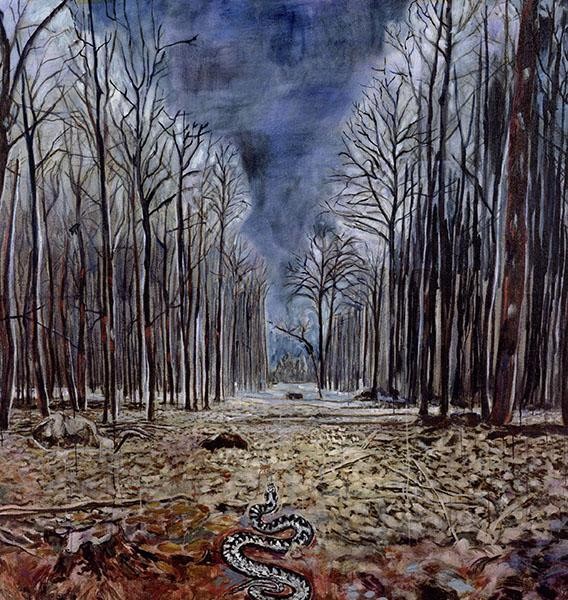Anselm Kiefer
16 Dec 2015 - 18 Apr 2016
ANSELM KIEFER
16 December 2015 - 18 April 2016
Curator : Mnam/Cci, Jean-Michel Bouhours
The exhibition devoted to the work of Anselm Kiefer by the Centre Pompidou is unprecedented in terms of scope and selection. It provides a retrospective journey through the prolific career of the celebrated German artist from the late Sixties to the present day. Around sixty paintings, brought together for the first time from major private and public collections throughout the world, dialogue with installations, showcases and books in an exhibition designed as a series of dramatic moments in the artist's career, with his entire approval.
Kiefer was born in the spring of 1945. During the Seventies, he, Georg Baselitz, Gerhardt Richter, Sigmar Polke and Jorg Immendorff participated in the revival of German painting, which emerged in an international context marked by Neo-Expressionism. Kiefer rapidly established a highly singular style, marked by an obsession with history and myths from German culture. Immersion in the past and memory are his strategy for answering the question gnawing at this generation of artists: how to create after Hitler, in response to Theodor W Adorno's celebrated injunction that "any culture after Auschwitz, including its urgent criticism, is only a pile of filth."
In 1984, when he went to Israel for an exhibition, Kiefer became even more acutely aware of the loss of Yiddish culture within the heart of Germany's culture, and grief for it, because of the "final solution". He was then studying the philosophy of the Talmud and the texts of the Kabbalah, particularly through the writings of Gershom Scholem and Isaac Louria. At the time, the artist was inspired by complex concepts such as Tzimtzum (contraction) and Shevirat ha-kelim (the shattering of vessels). Kiefer began to build up a body of work that moved away from traditional Western figuration moving into the realm of symbolism, or a "presence".
In his compositions, he often cites the polyhedron present in Melencolia (1514), the well-known engraving by Albrecht Dürer. Kieferian melancholy lies not in the register of geometry so much as that of grief: grief for a culture sullied by the exploitation brought about by totalitarianism; grief for a Jewish culture, with the addition of a meditation on ruin as a creative principle. This question, which he integrates into our collective present through architectonic references and the materials used in his works, like lead and ash, is an allegory of the vanity of mankind in general and the artist in particular.
16 December 2015 - 18 April 2016
Curator : Mnam/Cci, Jean-Michel Bouhours
The exhibition devoted to the work of Anselm Kiefer by the Centre Pompidou is unprecedented in terms of scope and selection. It provides a retrospective journey through the prolific career of the celebrated German artist from the late Sixties to the present day. Around sixty paintings, brought together for the first time from major private and public collections throughout the world, dialogue with installations, showcases and books in an exhibition designed as a series of dramatic moments in the artist's career, with his entire approval.
Kiefer was born in the spring of 1945. During the Seventies, he, Georg Baselitz, Gerhardt Richter, Sigmar Polke and Jorg Immendorff participated in the revival of German painting, which emerged in an international context marked by Neo-Expressionism. Kiefer rapidly established a highly singular style, marked by an obsession with history and myths from German culture. Immersion in the past and memory are his strategy for answering the question gnawing at this generation of artists: how to create after Hitler, in response to Theodor W Adorno's celebrated injunction that "any culture after Auschwitz, including its urgent criticism, is only a pile of filth."
In 1984, when he went to Israel for an exhibition, Kiefer became even more acutely aware of the loss of Yiddish culture within the heart of Germany's culture, and grief for it, because of the "final solution". He was then studying the philosophy of the Talmud and the texts of the Kabbalah, particularly through the writings of Gershom Scholem and Isaac Louria. At the time, the artist was inspired by complex concepts such as Tzimtzum (contraction) and Shevirat ha-kelim (the shattering of vessels). Kiefer began to build up a body of work that moved away from traditional Western figuration moving into the realm of symbolism, or a "presence".
In his compositions, he often cites the polyhedron present in Melencolia (1514), the well-known engraving by Albrecht Dürer. Kieferian melancholy lies not in the register of geometry so much as that of grief: grief for a culture sullied by the exploitation brought about by totalitarianism; grief for a Jewish culture, with the addition of a meditation on ruin as a creative principle. This question, which he integrates into our collective present through architectonic references and the materials used in his works, like lead and ash, is an allegory of the vanity of mankind in general and the artist in particular.

